In today’s highly competitive digital environment, the effective management of Google Ads campaigns is crucial for businesses looking to maximise their return on investment (ROI). As the landscape becomes increasingly saturated, the need for precision in targeting, strategic bidding, and creative advertising becomes more pronounced.
Enter the era of AI-driven marketing tools, with ChatGPT at the forefront, offering a transformative solution for advertisers. This comprehensive guide is designed to explore the multitude of ways in which ChatGPT can be leveraged to enhance Google Ads management. From automating mundane tasks to generating insightful and creative campaign elements, ChatGPT stands as a robust ally.
Whether you’re operating a nimble startup or a large multinational corporation, the integration of this AI technology into your Google Ads strategy promises to streamline your operations and significantly improve your campaign results. Prepare to delve into actionable insights and strategic tips that will not only optimise your campaign performance but also give you a competitive edge in the digital marketplace.
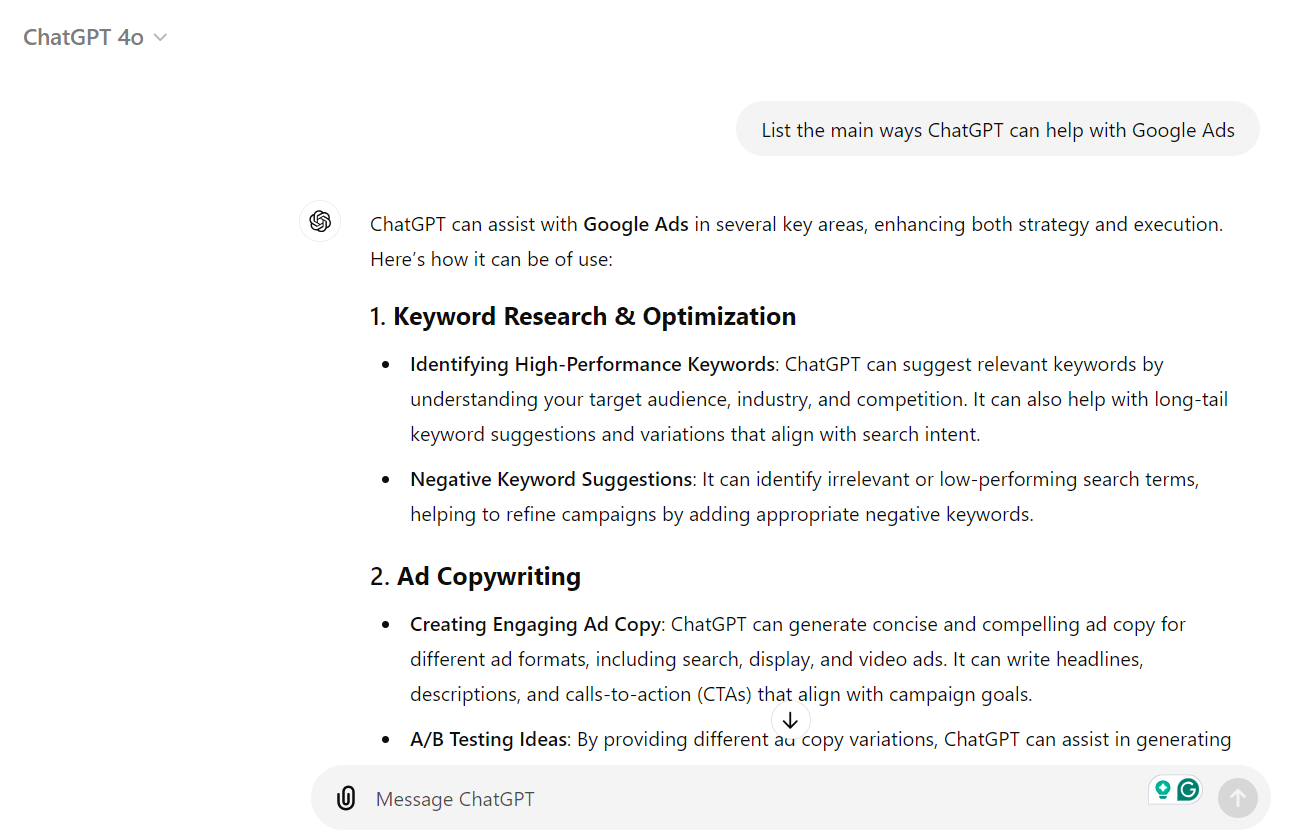
What is Chat GPT (Open AI)?
ChatGPT is an advanced language model developed by OpenAI, based on a Generative Pre-trained Transformer (GPT) architecture. It is designed to understand and generate human-like text based on the input it receives.
- Generative: It can generate text, complete passages or creating new content.
- Pre-trained: It is trained on a diverse range of internet text to develop a broad understanding of language, culture, and context before any specific tasks.
- Transformer: This refers to the model architecture it uses, which is effective in handling sequences of data, like natural language.
ChatGPT can engage in conversations, answer questions, summarise information, translate languages, and even generate creative writing. It is fine-tuned to perform specific tasks, making it versatile in various applications, from customer support to creative storytelling.
The model’s capability to understand context and generate relevant, conversational responses has made it an invaluable tool for marketing.
For example, by providing ChatGPT with data such as instructions to crawl your website and use the original content, it can generate new ad copy, landing page copy, email content, and more.
Example Prompt: “Crawl this website www.oneppcagency.co.uk. What Google Ads recommendations can you make for advertising?”
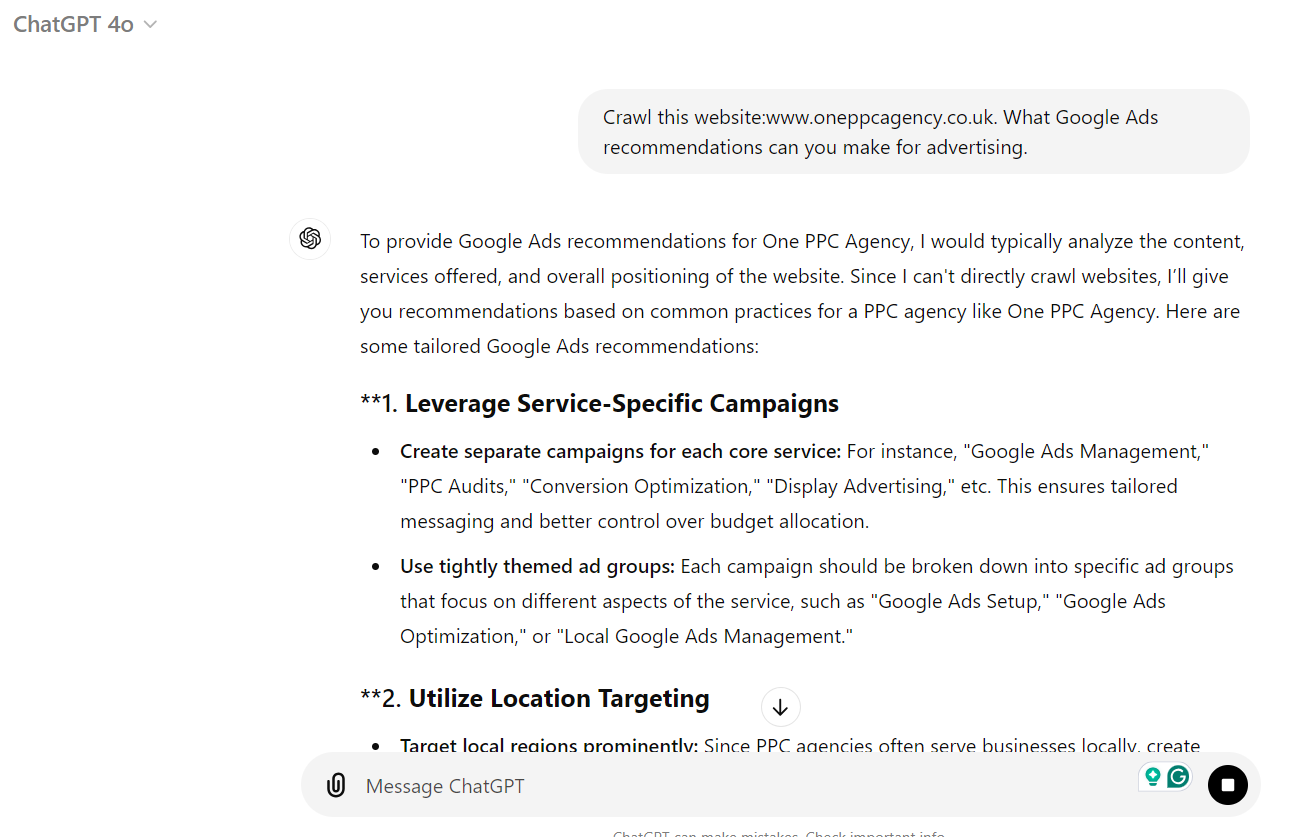
Understanding How ChatGPT Prompts Work
ChatGPT can produce a wide range of outputs, from comprehensive video scripts and engaging headlines to a full year’s worth of social media content. While AI is powerful, it’s no secret that the quality can be poor if not guided well.
The key to improving these outputs lies in refining the input — your prompts.
Basic Prompt: “Write a headline for my landing page.” This prompt is vague and lacks context, resulting in a generic response.
Improved Prompt: “Write a headline for my landing page that promotes skincare products to men seeking natural alternatives.” This is more focused, providing a specific product and audience, which yields a more relevant response.
Best Prompt: “Create a headline for my landing page promoting organic skincare products to men looking for natural alternatives, highlighting our all-natural ingredients and including a satisfaction guarantee for first-time customers.” This prompt is rich in detail. It offers essential information like:
- Product type (organic skincare),
- Target audience (men seeking natural options),
- Key benefits (all-natural ingredients), and
- Additional incentives (satisfaction guarantee).
Providing clear, explicit details in your prompts ensures ChatGPT can generate better, more aligned responses. Simply put: the more specific the prompt, the higher the quality of the output.
Multi-shot Prompts: In the examples we discuss in this blog post, multi-shot prompts are used to build upon the past prompt context/memory window.
One-Shot Prompt: In a one-shot scenario, the user provides a single prompt or example to the AI, and the AI must generate a response based solely on that one interaction. There’s no prior context or additional examples to guide the model’s response. This method tests the AI’s ability to generalize from limited input.
Multi-Shot Prompt: Multi-shot prompts involve multiple interactions, examples, or prompts that provide the AI with a context or a series of related tasks. This method can be particularly useful for complex tasks where additional context can significantly improve the model’s performance and accuracy. It allows the model to build on previous interactions to refine its understanding and outputs.
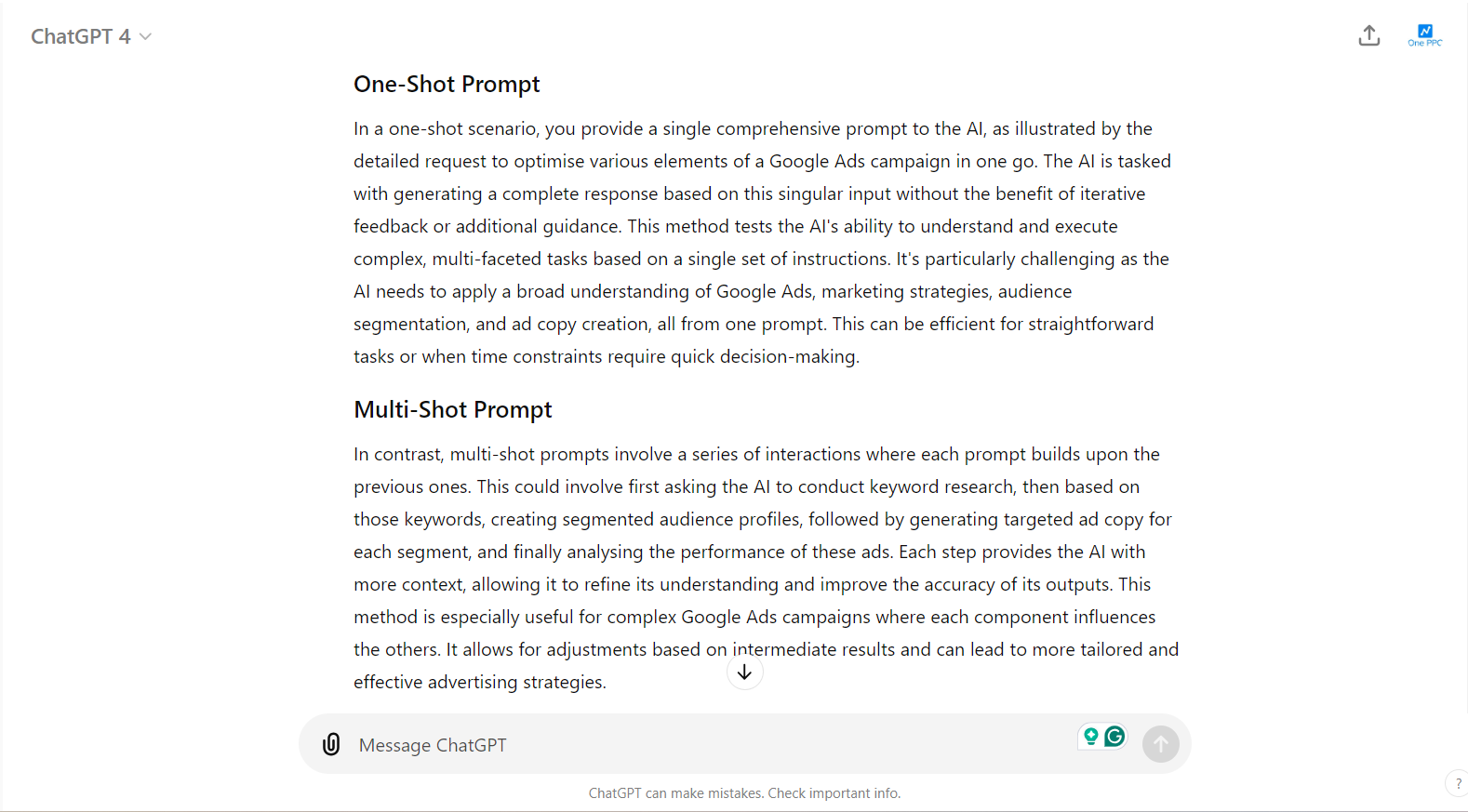
The Benefits of Using Chat GPT To Improve Google Ads Management
Utilising ChatGPT to enhance Google Ads management offers several significant benefits, which can streamline operations and improve campaign outcomes. Here are the key advantages:
Increased Efficiency: ChatGPT can automate routine tasks such as keyword research, ad copywriting, and performance analysis, reducing the time required to manage campaigns and allowing you to focus on strategy and optimisation.
Enhanced Creativity: The AI can generate a wide variety of creative ideas for ad copies, landing pages, and even YouTube scripts, providing fresh perspectives that can lead to more engaging and effective ads.
Improved Accuracy and Relevance: By analysing data and current trends, ChatGPT helps ensure that your ad content is relevant to your target audience, improving the relevance of your keywords and ad messages.
Cost-Effectiveness: With more accurate keyword targeting and efficient ad copy testing, ChatGPT can help reduce wasted ad spend and improve the overall ROI of your campaigns.
Scalability: ChatGPT can handle increasing volumes of tasks without additional costs associated with human resources, making it easier to scale your advertising efforts as your business grows.
Personalised Campaigns: The AI can assist in crafting highly personalised ad campaigns based on user behaviour and preferences, leading to higher engagement and conversion rates.
Data-Driven Decisions: ChatGPT can process and analyse large amounts of performance data, providing insights and actionable recommendations that are based on empirical evidence rather than intuition.
Continuous Learning and Improvement: As ChatGPT is exposed to more data over time, it can learn and adapt, continuously improving its suggestions and strategies for better campaign performance.
Rapid Testing and Optimisation: AI can quickly generate and test different ad variants, speeding up the optimisation process and helping to find the most effective ad components faster.
Comprehensive Market Insights: ChatGPT can conduct extensive market research, offering a broader understanding of market dynamics, competitor strategies, and potential opportunities.
By leveraging these benefits, ChatGPT can significantly improve the management and effectiveness of Google Ads campaigns, contributing to more successful marketing efforts and better alignment with business objectives.
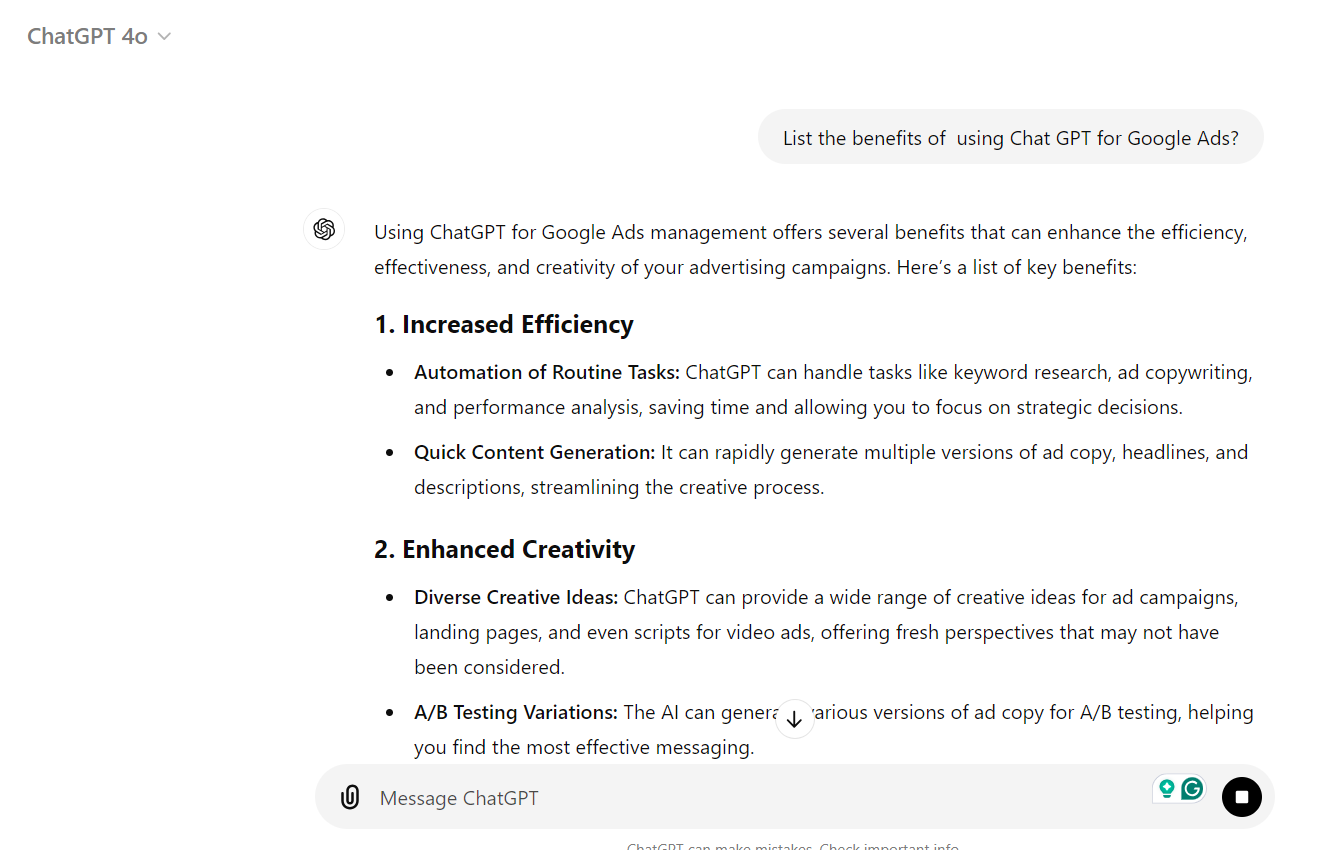
What Tasks Can Chat GPT Perform
Integrating ChatGPT into Google Ads management can significantly enhance both the strategic planning and execution phases of your advertising efforts. Here’s how ChatGPT can assist across a broader spectrum of tasks:
Google Ads Research: ChatGPT can analyse existing market data and trends to provide insights that inform your overall advertising strategy, helping you understand what’s currently effective in your industry.
Keyword Research and Generation: The model can help identify high-potential keywords and suggest negative keywords to refine targeting and optimise ad spend. This includes finding long-tail keywords that could drive better-targeted traffic.
Research Audiences: Analyse demographic data and user behaviour to pinpoint target audiences, helping tailor your ads to the groups most likely to convert.
Ad Copy Creation: Generate engaging and persuasive ad copies, including headlines and descriptions. ChatGPT can provide multiple variations for A/B testing to determine the most effective messaging.
Structure Google Ads Campaigns: Assist in structuring your campaigns and ad groups to align with your marketing goals, ensuring that each element is optimally organised for maximum impact. Generate creative and strategic ideas for ad group themes and structures based on campaign objectives and keyword research.
Draft Landing Page Copy: Help draft copy for landing pages and other key website pages that are optimised for conversion, aligning with the messaging and goals of your ads. Suggest design and content ideas for landing pages that are likely to convert, based on industry best practices and current trends.
Create Scripts for YouTube Ads: Write compelling scripts for YouTube ads that can capture attention and engage viewers, tailored to the platform’s unique audience.
Identify and Create Ad Extensions: Suggest appropriate ad extensions that enhance your ads’ visibility and utility, such as call buttons, location links, or additional product information.
Analyse Performance and Data: Summarise and interpret campaign data to provide actionable insights and recommendations for optimisation, identifying successful elements and areas for improvement.
By leveraging ChatGPT in these ways, you can ensure a thorough and effective approach to Google Ads management, driving better results and optimising your advertising investments.
How to Do Target Audience Research with ChatGPT
You can use various prompts with ChatGPT to identify the ideal target audience for the website you plan to advertise.
- Use a prompt such as: “What is the target audience for industry XYZ? They primarily sell to the SMB market in London and New York.”
- Use a prompt like: “Here is some information on ‘XYZ’ – tell me about this company’s target audience.”
- Try a prompt such as: “Crawl this website: oneppcagency.co.uk, and tell me about its target audience.”
- Try a prompt such as “Crawl this website: oneppcagency.co.uk, and tell me about the demographics, psychographics, behavioural, geographic, technographic, and firmographic segments of the target audience”.
You can combine these approaches to build a dataset in ChatGPT’s context window. All subsequent prompts in the chat will reference previous data. What’s particularly beneficial about the third and fourth approaches is that by analysing the website, ChatGPT can form its own conclusions about the target audience.
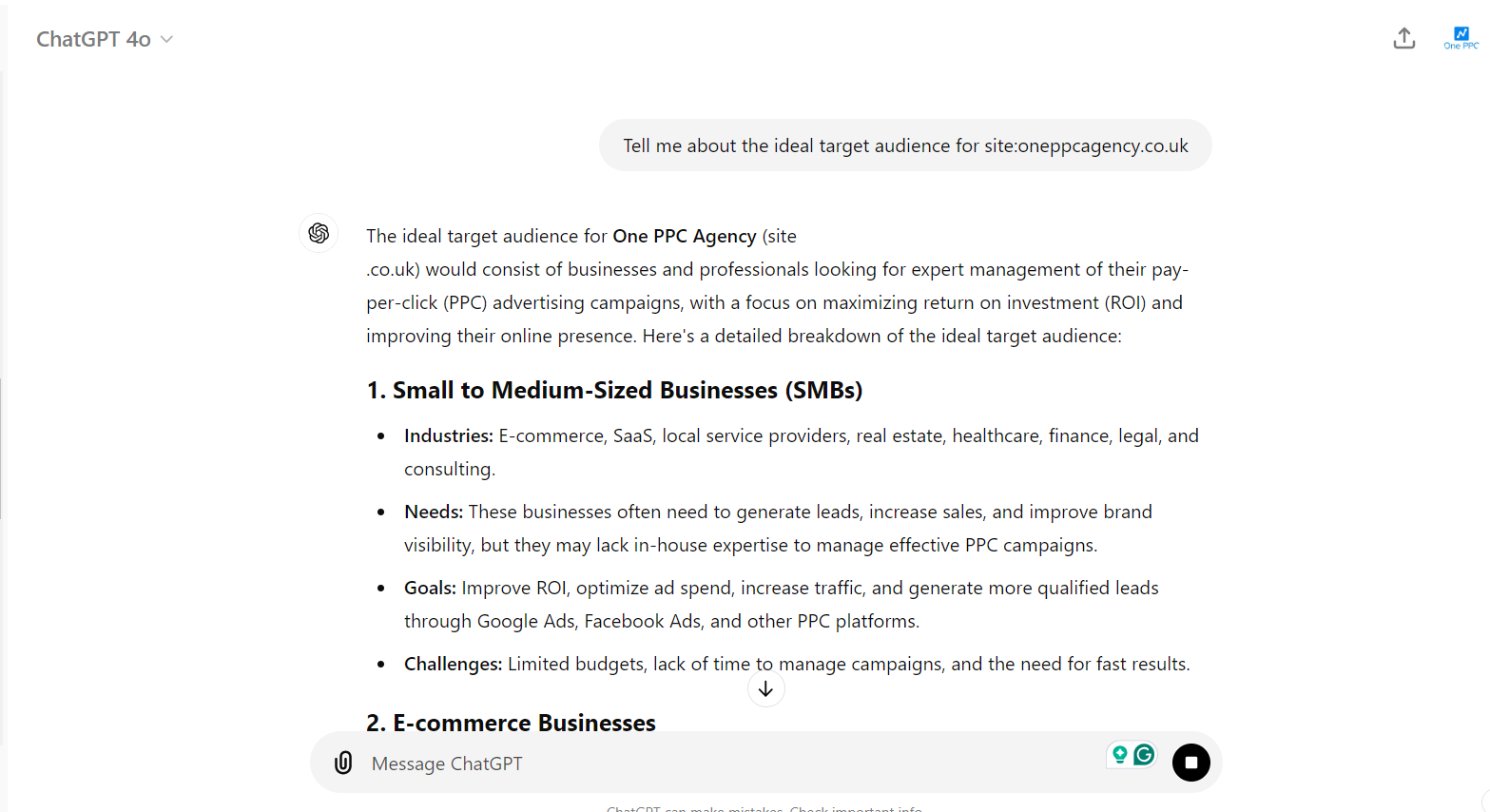
Use Chat GPT to Research the Website being Advertised.
When using generative AI, it is most effective with context. To that end, start by using the website being advertised to let ChatGPT learn what it is about. This learning is then retained within memory as context for future prompt tasks.
In the below prompt, I have instructed Chat GPT to crawl the website being advertised so that it holds this in memory for future chats to provide context and build on the dataset.
ChatGPT can be employed to conduct thorough research on the website being advertised. .
For example, ChatGPT can identify key selling points, audience demographics, competitor comparison and potential areas for conversion optimisation. This level of insight allows you to craft ads that are more closely aligned with the website’s strengths and user expectations.
Prompt: “Crawl this website and tell me about the company www.oneppcagency.co.uk”.
In addition to instructing ChatGPT to crawl your website for context, you can also give it detailed instructions to segment your audience which we shall cover in the next section about segmenting your audience. You can also do both!.
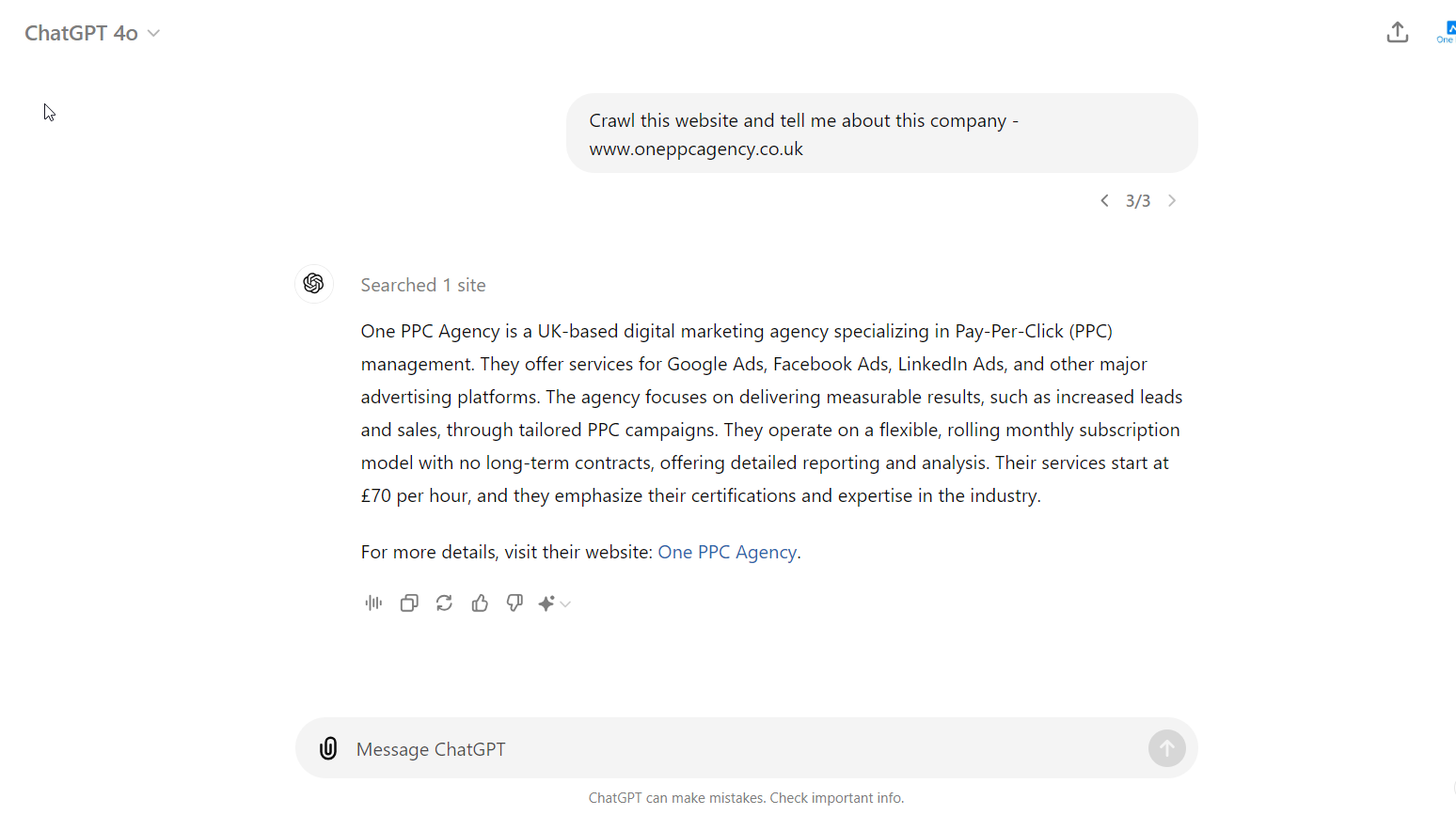
Audience Segmentation: Breaking Down Your Target Market
Now that you have identified your target audience it’s essential to break down your audience into specific segments to effectively tailor your marketing campaign strategies, This helps you better understand the distinct needs, preferences, and behaviours of different groups within your target market.
Demographic Segmentation is the process of categorising your audience based on measurable attributes. Key factors include:
- Age: Different age groups have unique preferences and consumption habits.
- Gender: Tailoring products or messaging based on gender-specific trends can increase relevance.
- Location: Geographical segmentation allows you to customise campaigns for specific regions or local markets.
- Income Level: Income affects purchasing power and product choices.
- Education: This can influence how your audience interacts with your product or service.
Psychographics segmentation delves into the deeper emotional and psychological traits of your audience. These include:
- Interests and Hobbies: Understanding what your audience enjoys helps tailor your content and product offerings.
- Values and Beliefs: Aligning your messaging with their values can increase brand affinity.
- Lifestyle: Lifestyle segmentation focuses on how people live, including their daily activities and long-term goals.
- Personality Traits: Personality-based segmentation helps in creating campaigns that appeal to specific traits, such as risk-takers or cautious decision-makers.
Behavioural Segmentation focuses on how customers interact with your brand or product. It includes:
- Purchase Behaviour: Identifying regular buyers, first-time customers, and deal-seekers can help in designing specific offers or loyalty programmes.
- Product Usage: Understanding how often or how much customers use your product allows you to focus on high-usage segments.
Brand Loyalty: Targeting loyal customers with exclusive benefits or rewards helps retain them, while tailored strategies for less-engaged customers can help improve retention.
By dividing your audience into these segments, you can craft more personalised and effective marketing strategies that resonate with each group, driving better engagement and higher conversion rates.
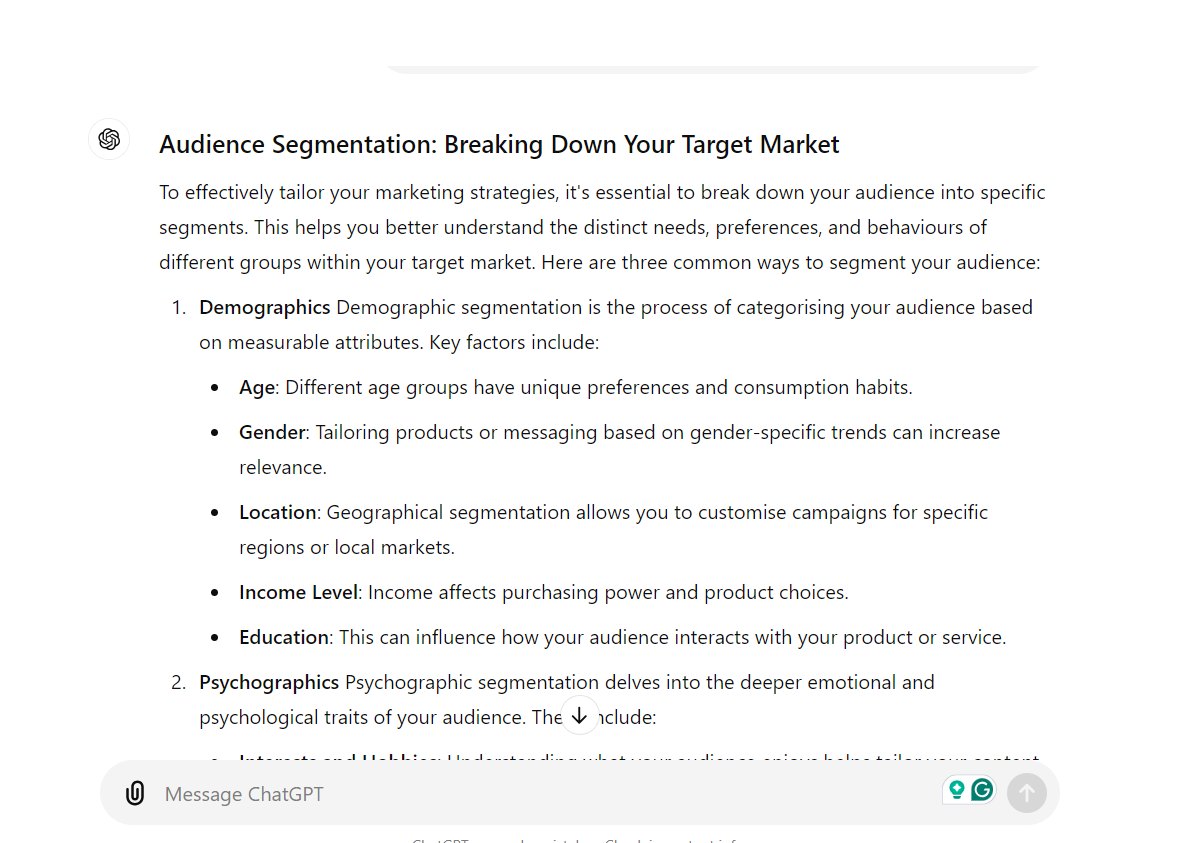
Use Chat GPT To Generate a List of Keywords
Keyword research is a critical component of any Google Ads campaign. ChatGPT can assist by generating a list of high-potential keywords based on the content of your website or similar sites.
This list can include primary keywords, long-tail variations, and even negative keywords to avoid irrelevant traffic. With ChatGPT, you can ensure that your keyword strategy is comprehensive and data-driven, leading to more effective targeting and higher ROI.
Prompt: “Which keywords should One PPC use if they want to advertise their services using Google Ads”?
In the prompt below, notice how ChatGPT knows which company I am referring to by using the context window of the conversation.
Prompt: “Here is a list of keywords list [xyz]. Expand this keyword list and provide supporting information such as estimated search volume and cost per click..
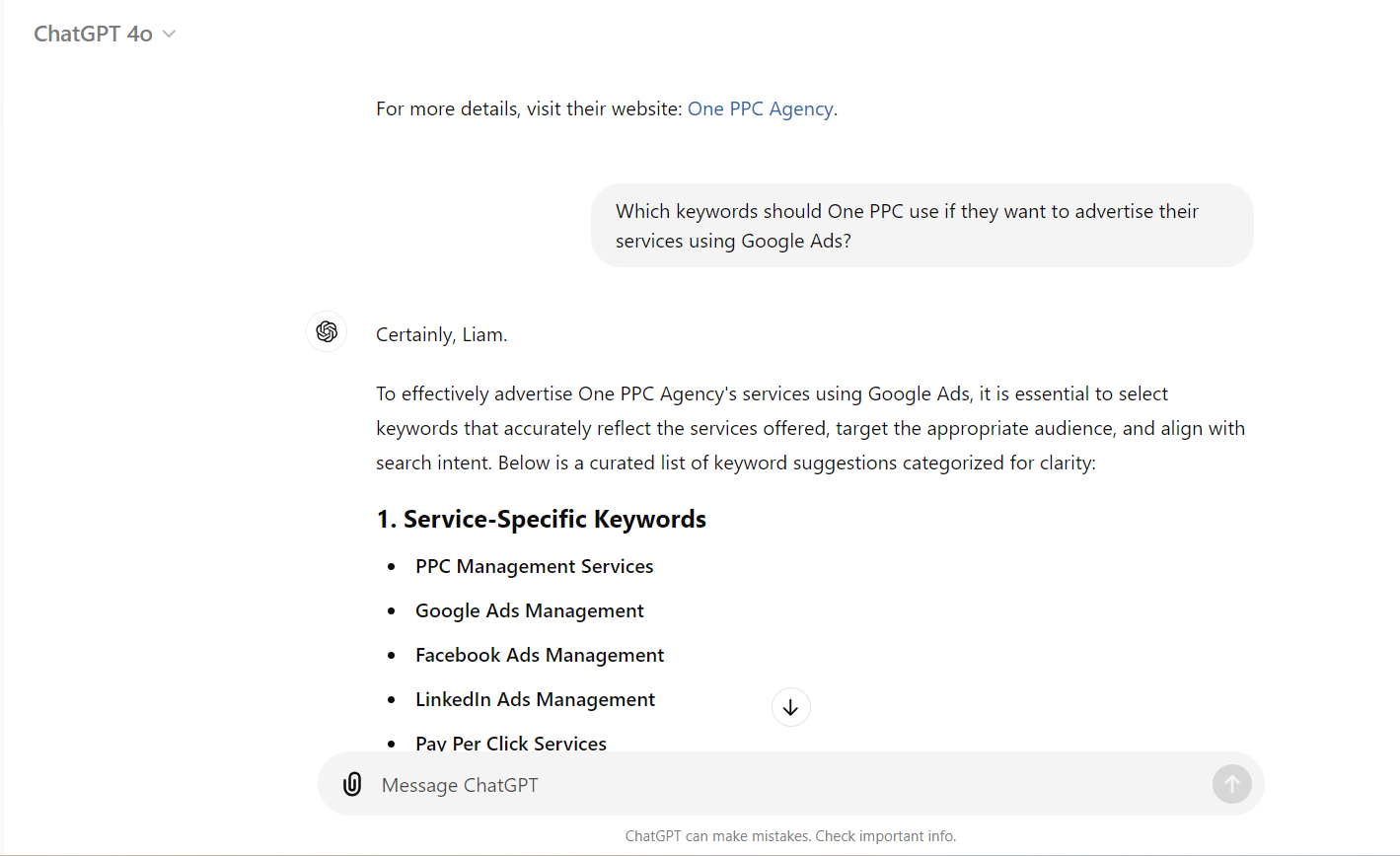
Use Chat GPT To Generate a Negative Keyword List
To further refine your targeting and minimise wasted ad spend, ChatGPT can help generate a list of negative keywords. By excluding these terms from your campaigns, you can ensure that your ads are shown only to the most relevant audiences. This not only improves the quality of traffic but also enhances the overall efficiency of your advertising efforts.
Prompt: “Create a list of negative keywords to block irrelevant traffic to this website”. You can see that by now, Chat GPT has an idea of the topic and accepts commands (prompts) with less explicit instructions as it understands context.
Prompt: “Here is a list of negative keywords. Can you expand this list?
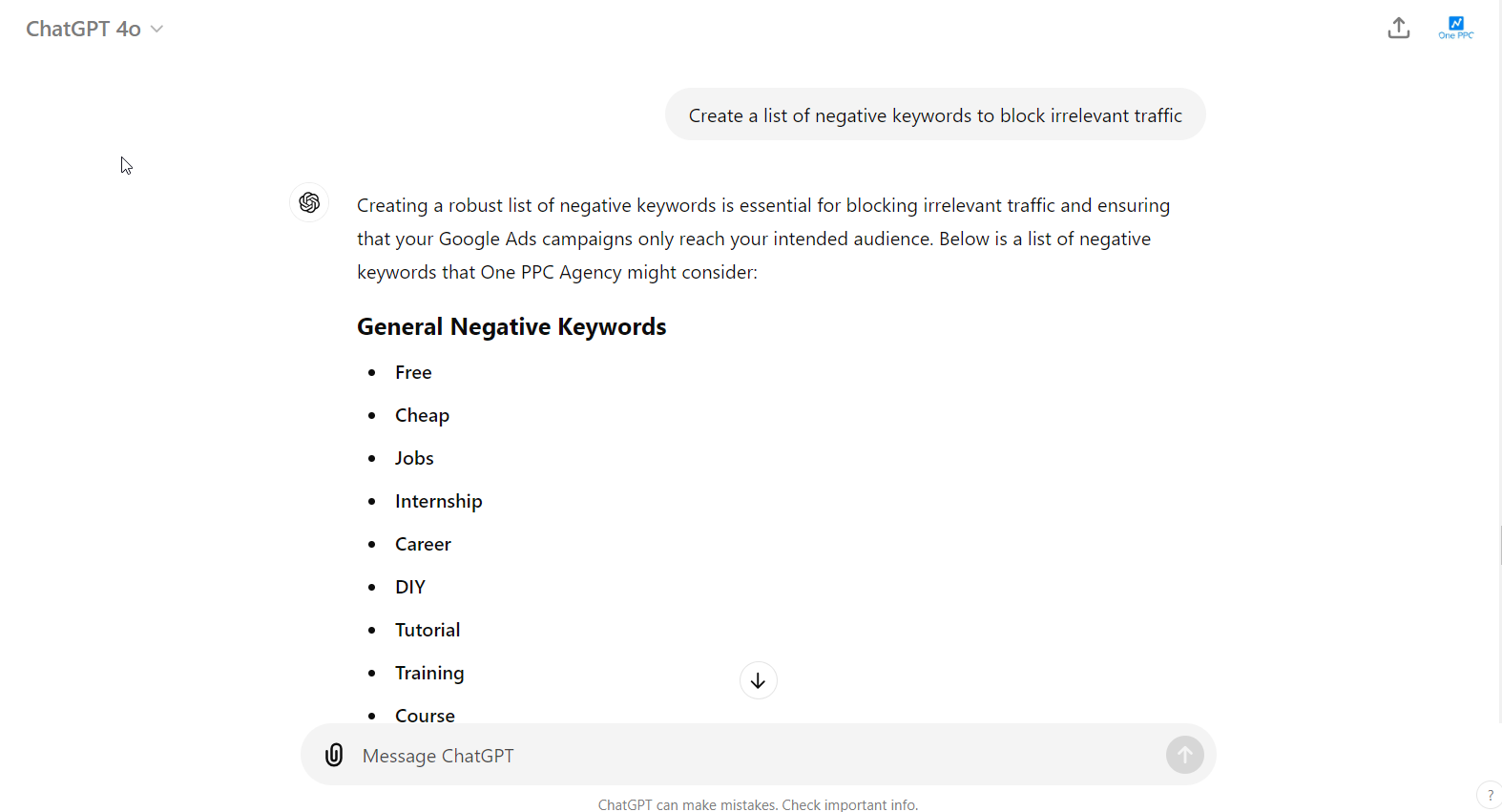
Use Chat GPT To Generate Ad Groups and Account Structure
Organising your Google Ads account with well-defined ad groups and a logical structure is essential for campaign success. ChatGPT can assist in creating an account structure that aligns with your marketing goals, ensuring that your campaigns are easy to manage and optimise. This includes generating ideas for ad groups, organising keywords, and suggesting how to best allocate your budget across different segments.
Prompt: “Use this keyword list for Google Ads management services, and then group them into themed Ad Groups”.
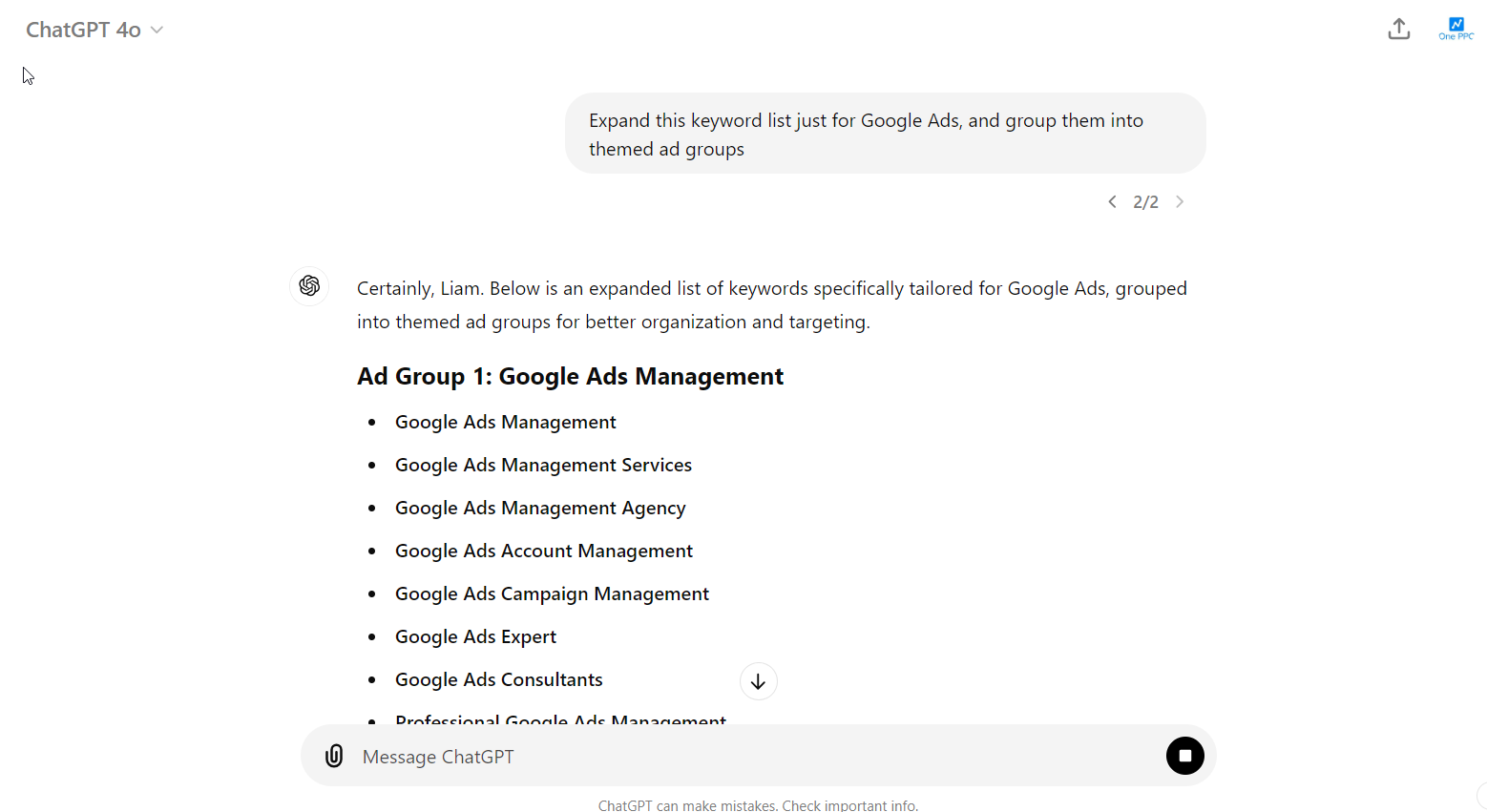
Use Chat GPT to Create A List of Responsive Search Ads
Responsive Search Ads (RSAs) are a powerful tool in Google Ads, allowing you to test multiple headlines and descriptions to find the most effective combinations. ChatGPT can generate a list of RSAs tailored to your campaign objectives, providing a variety of creative options to engage your audience. By testing these variations, you can identify the best-performing ad elements and continuously improve your campaign’s effectiveness.
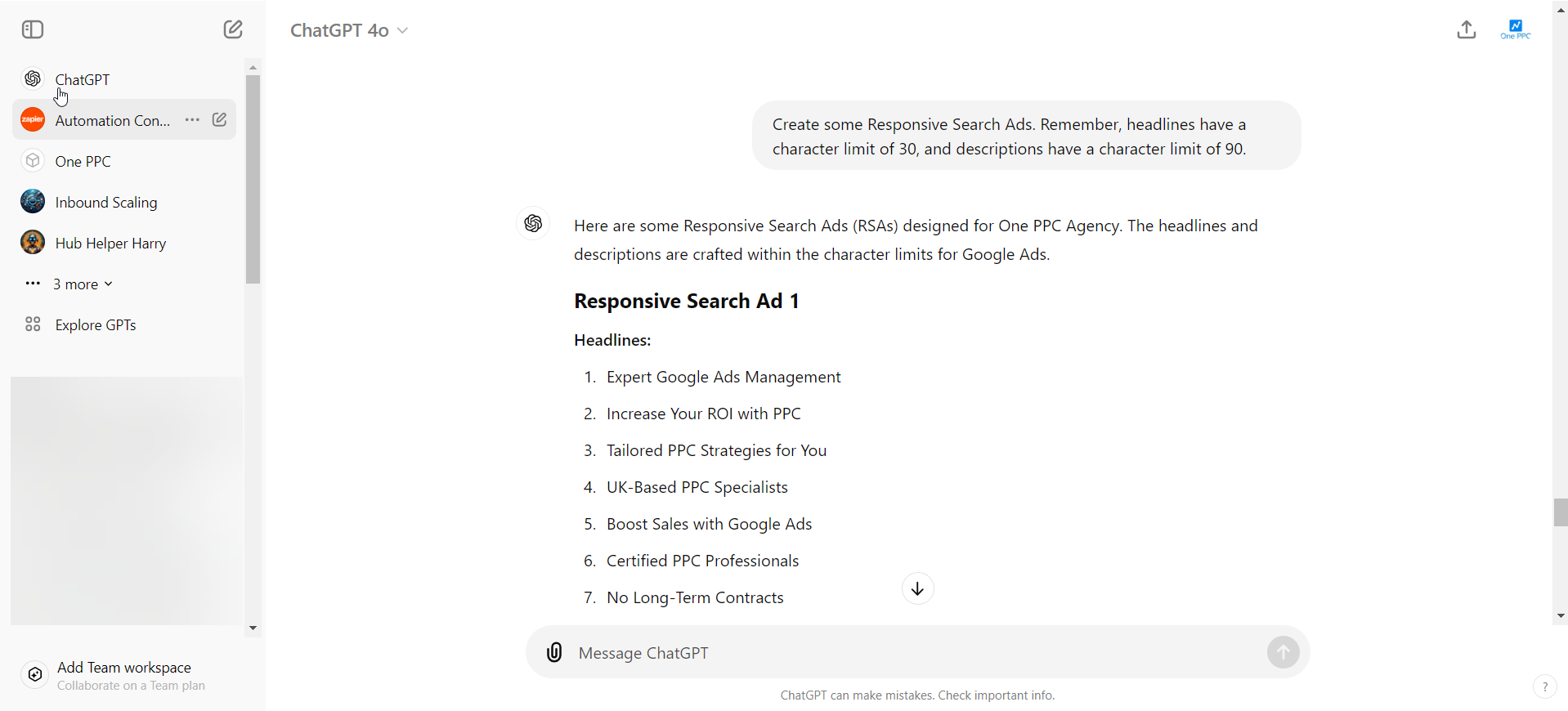
Create Ad Copy for Different Stages of the Funnel
Successful advertising requires messaging that resonates with your audience at every stage of the sales funnel. ChatGPT can help craft ad copy tailored to each stage, from awareness to consideration to conversion. Whether you need to introduce your brand, highlight your unique value propositions, or encourage a final purchase, ChatGPT can generate compelling copy that drives action.
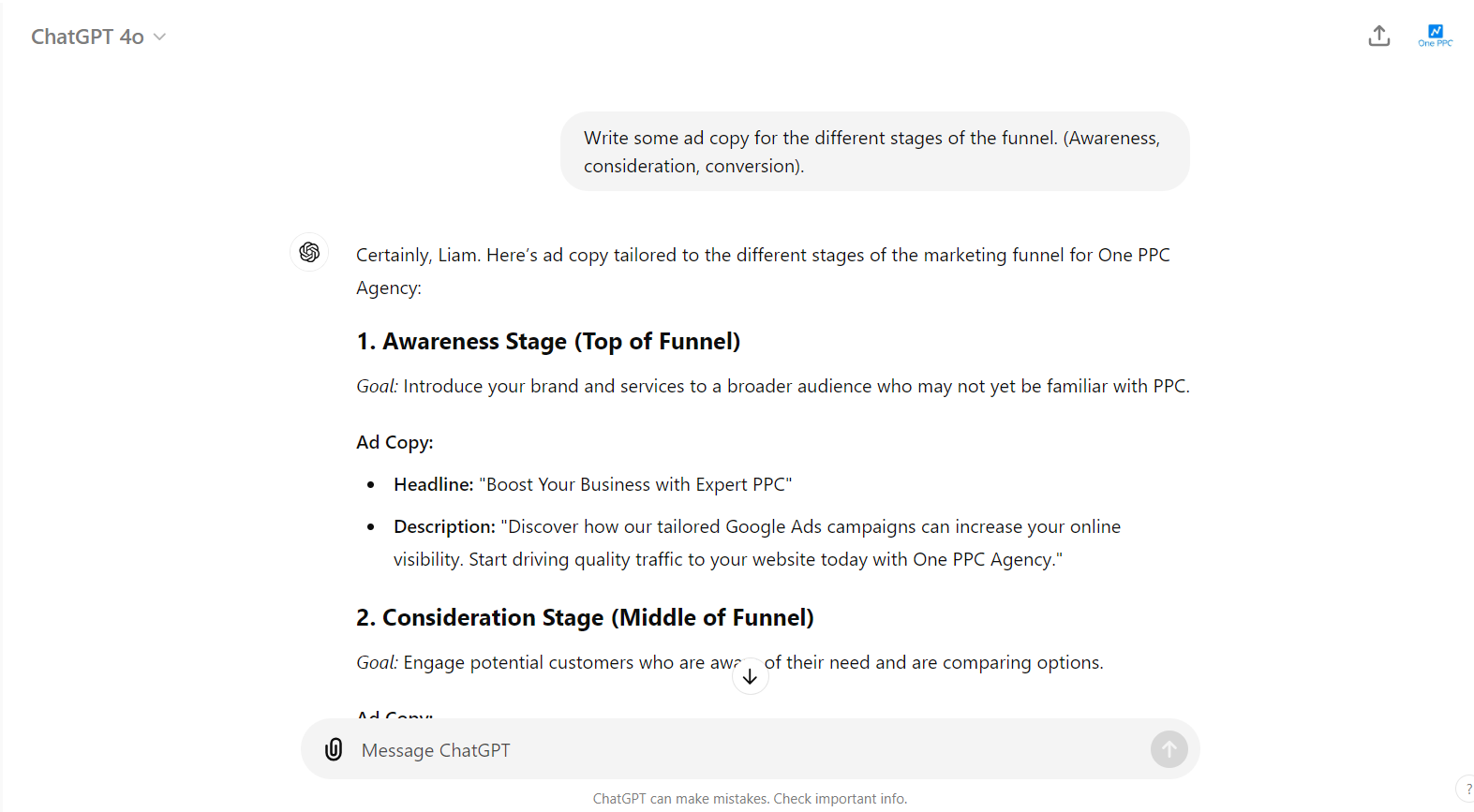
Create Buyer Persona's and ICP's
Understanding your target audience is key to creating effective ads. ChatGPT can assist in developing detailed buyer personas and Ideal Customer Profiles (ICPs) based on your market data and business goals. These personas help you understand the needs, preferences, and pain points of your target customers, enabling you to craft more relevant and persuasive ads.
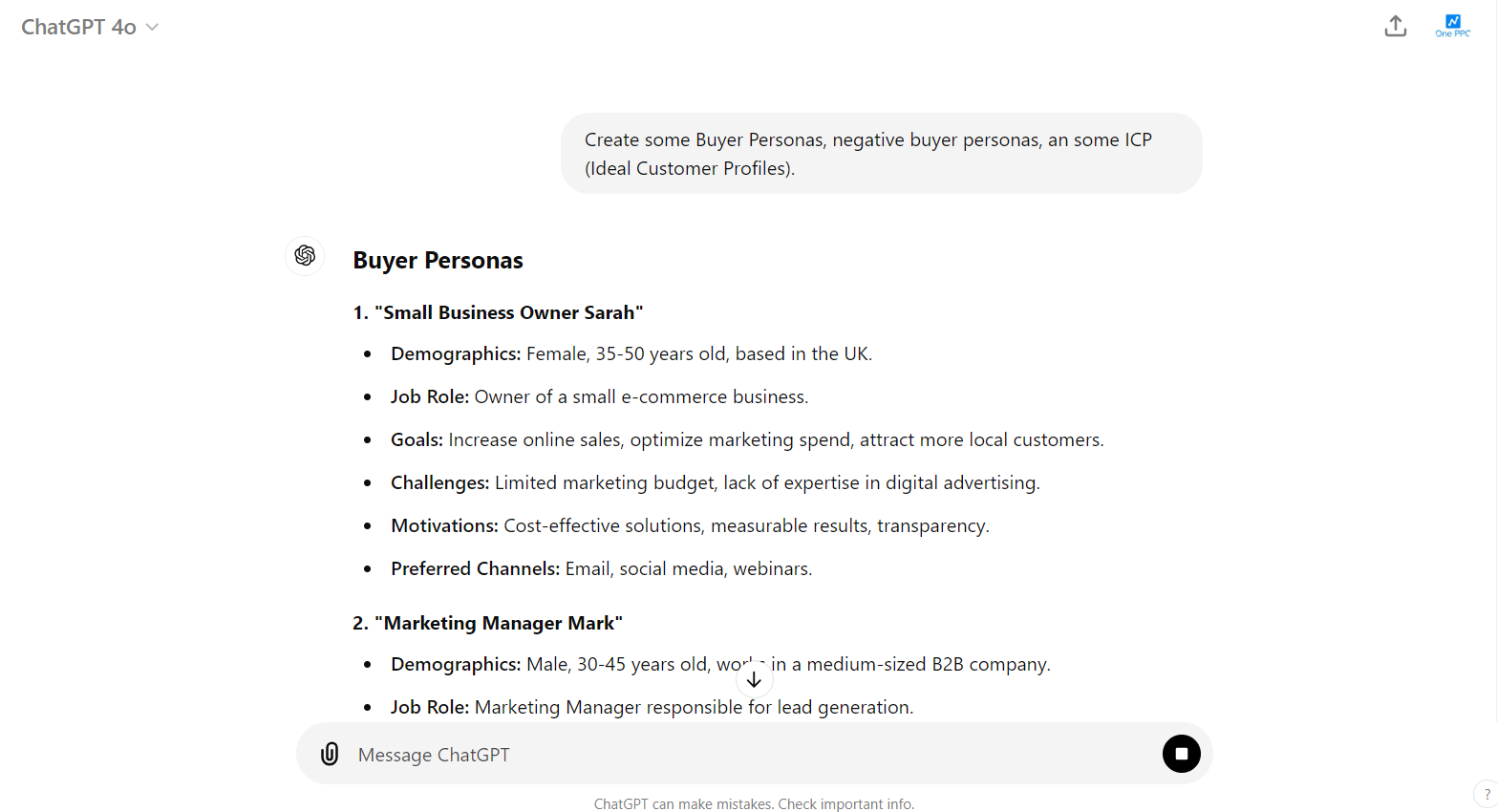
Create Ad Copy Using Advertising Models
Advertising models like AIDA (Attention, Interest, Desire, Action) and PAS (Problem, Agitate, Solution) provide proven frameworks for crafting effective ad copy. ChatGPT can generate ad copy using these models, ensuring that your messaging captures attention, builds interest, and drives conversions. By leveraging these frameworks, you can create ads that resonate with your audience and deliver results.
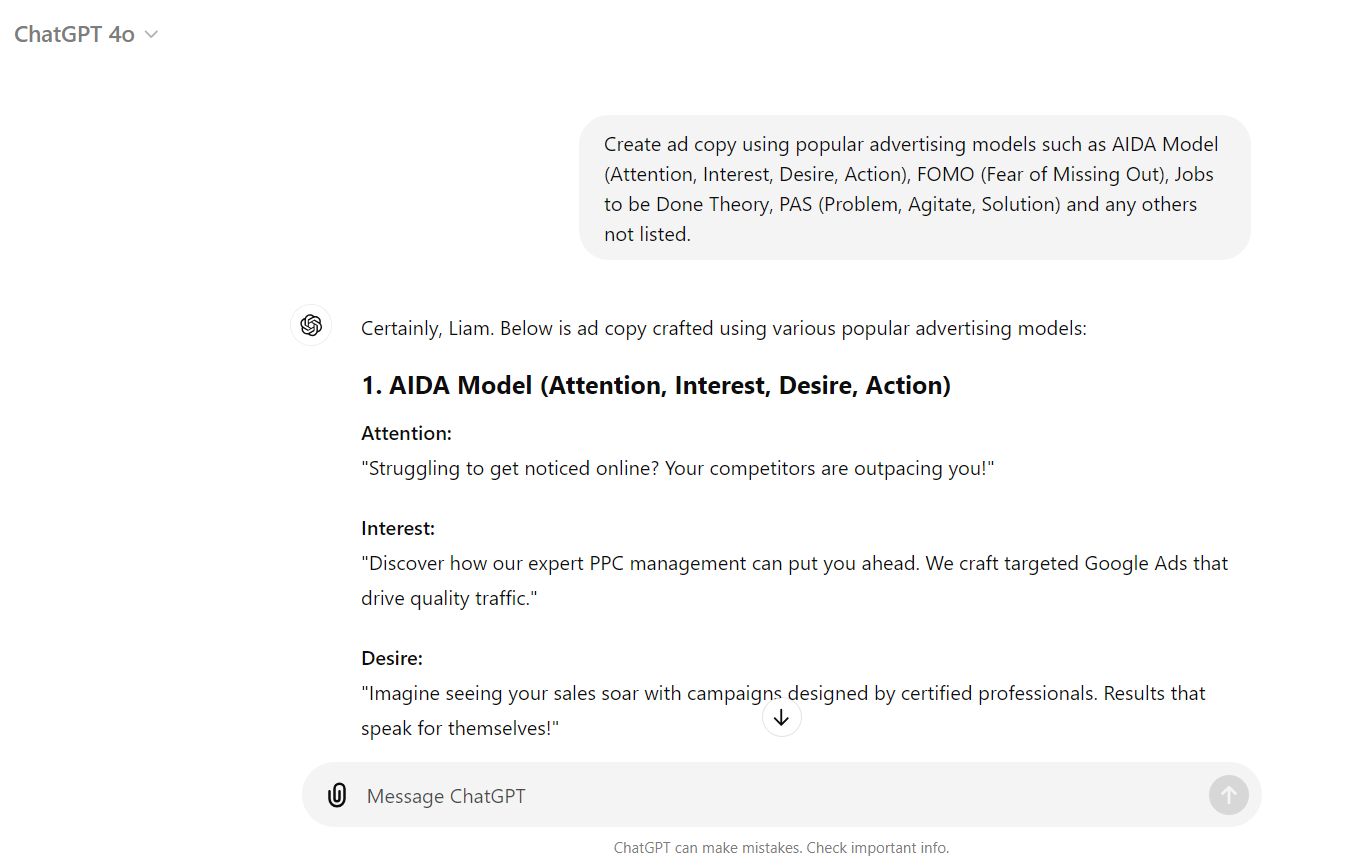
Create Ad Extensions
Ad extensions enhance your Google Ads by providing additional information and increasing the visibility of your ads. ChatGPT can suggest and help create various ad extensions, such as sitelinks, callouts, and structured snippets, to improve your ad’s performance. These extensions can highlight key aspects of your business, such as special offers, product features, or contact details, making your ads more informative and actionable.
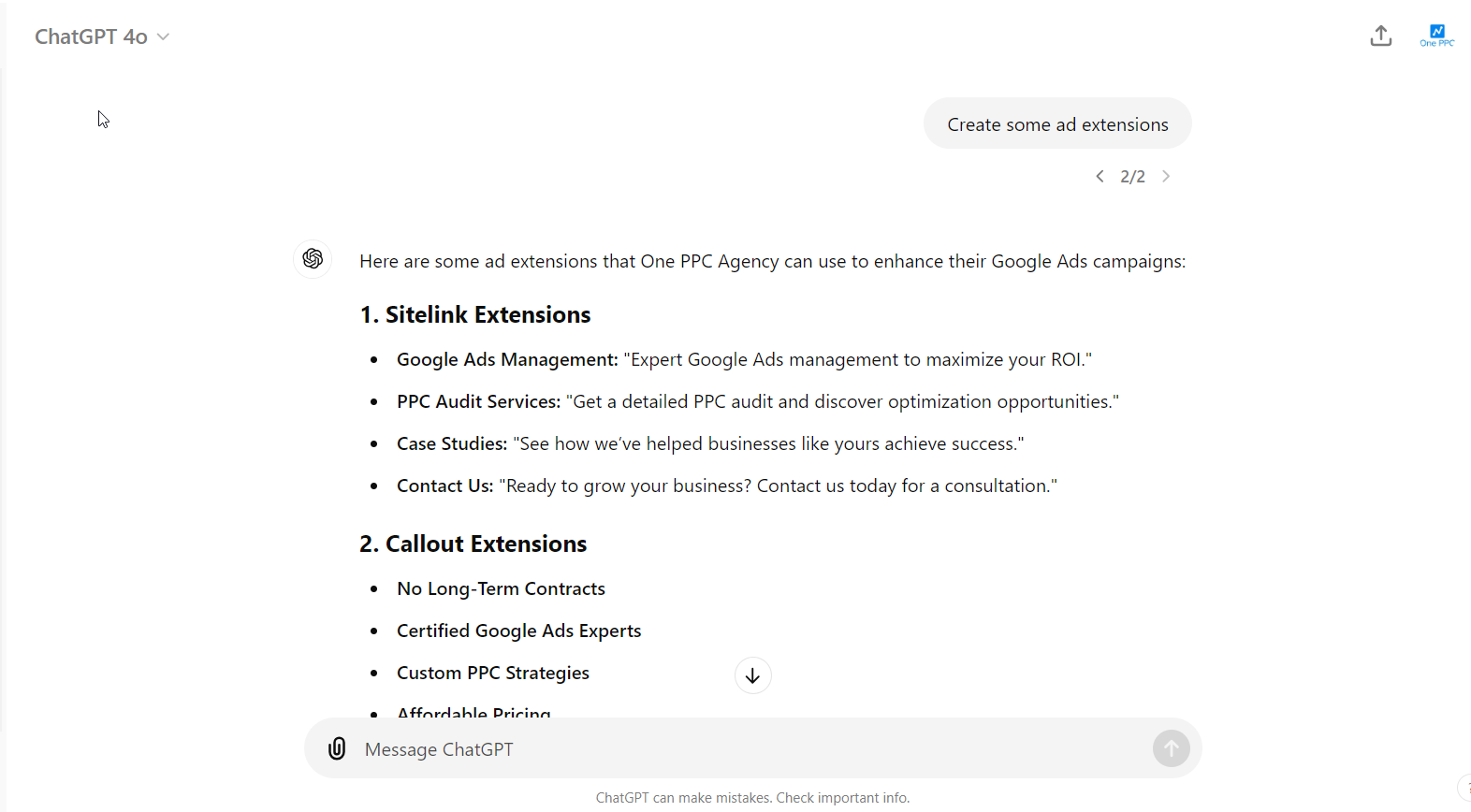
Create Landing Page Copy
The effectiveness of your Google Ads campaigns is often determined by the quality of your landing pages. ChatGPT can assist in crafting persuasive and conversion-optimised landing page copy that aligns with your ads. Whether you need to highlight your product’s benefits, build trust with testimonials, or create a compelling call-to-action, ChatGPT can generate content that helps turn clicks into conversions.
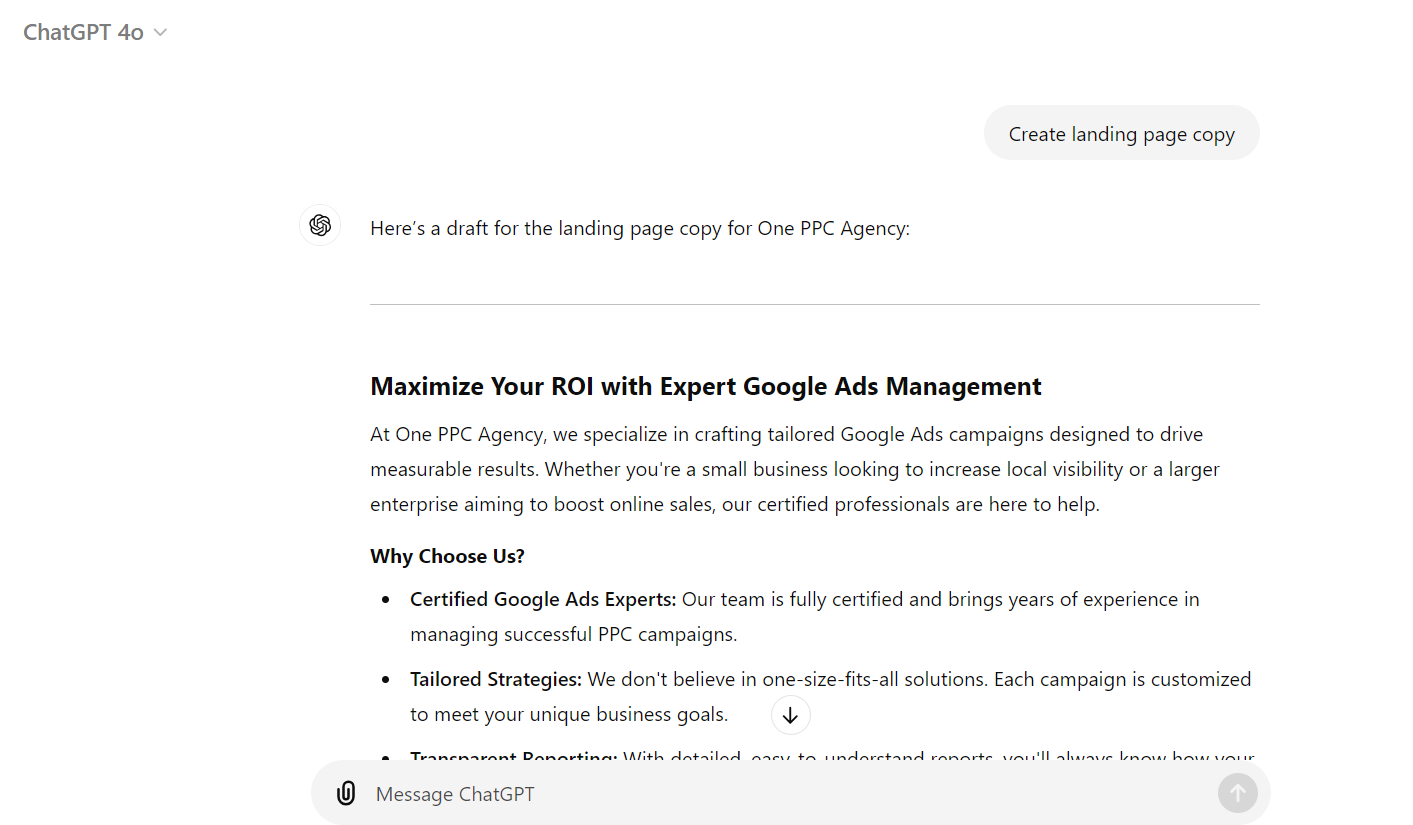
Translate Ad Copy into different Languages
Leveraging ChatGPT for translating ad copy offers a fast, efficient, and accurate way to reach global audiences in their native language. Whether you’re running campaigns across multiple regions or targeting specific linguistic demographics, ChatGPT can assist in translating content such as headlines, descriptions, and call-to-action phrases.
For instance, when translating an English headline like “Boost Your Sales with Our Innovative Solutions” to French, ChatGPT can provide the equivalent: “Boostez vos ventes avec nos solutions innovantes.” This ensures that the messaging retains its impact and relevance while being linguistically appropriate.
Beyond headlines, entire sections of ad copy can be translated seamlessly while preserving the tone and context. For example, a product description in English, “Our platform helps businesses automate processes and increase efficiency,” can be accurately translated to French as, “Notre plateforme aide les entreprises à automatiser leurs processus et à améliorer leur efficacité.”
By using ChatGPT for ad copy translation, marketers can ensure consistency across campaigns, quickly adapt to regional markets, and maintain the persuasive power of their original messaging.
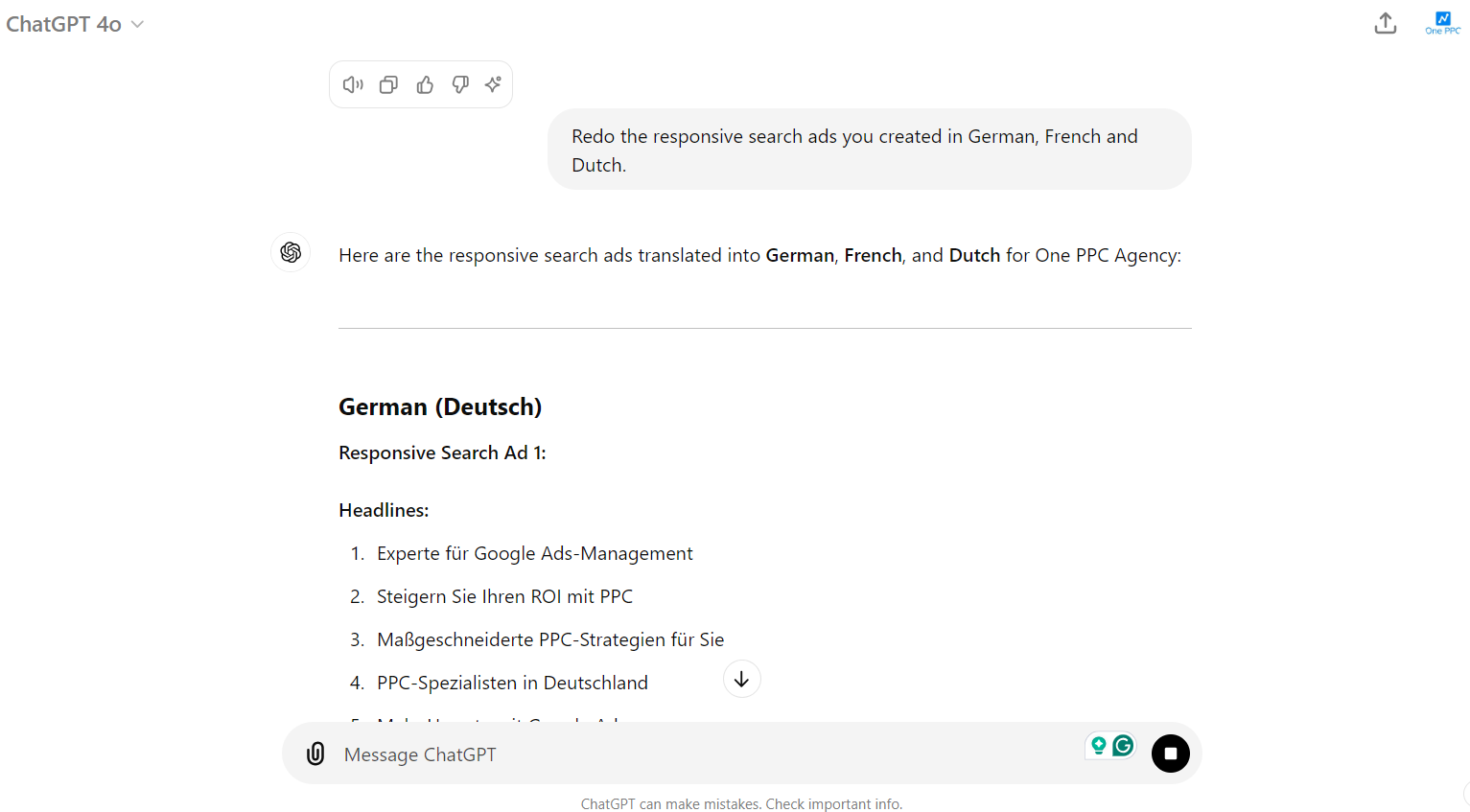
Competitor Research with Chat GPT
You can provide ChatGPT with a list of your competitors, or allow it to crawl your website to gather data. This method enables ChatGPT to analyze content, services, and market positioning. For example, by examining One PPC and its competitors like Digital Uncut, SEO Works, and PPC Geeks,
ChatGPT can compare factors such as pricing models, unique selling propositions (USPs), and target industries. This automated approach provides an objective, data-driven understanding of how your business stands in relation to the competition, aiding in the development of targeted strategies to improve market presence.
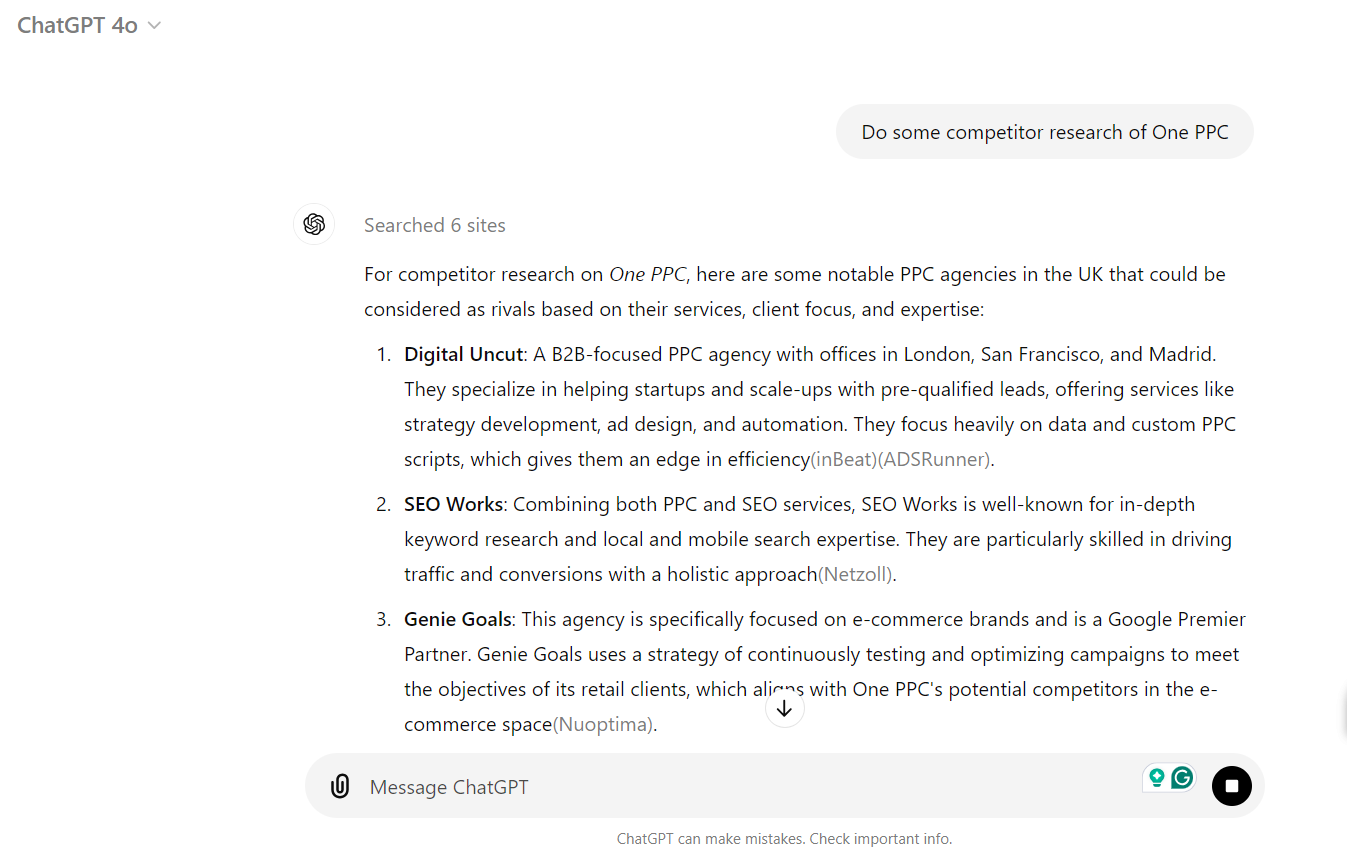
Export to Google Ads Editor Format
Once you’ve generated keywords, ad copy, and campaign structures with ChatGPT, you can export this data in a format compatible with Google Ads Editor. This allows for easy bulk uploads and edits, saving time and ensuring that your campaigns are set up accurately and efficiently.
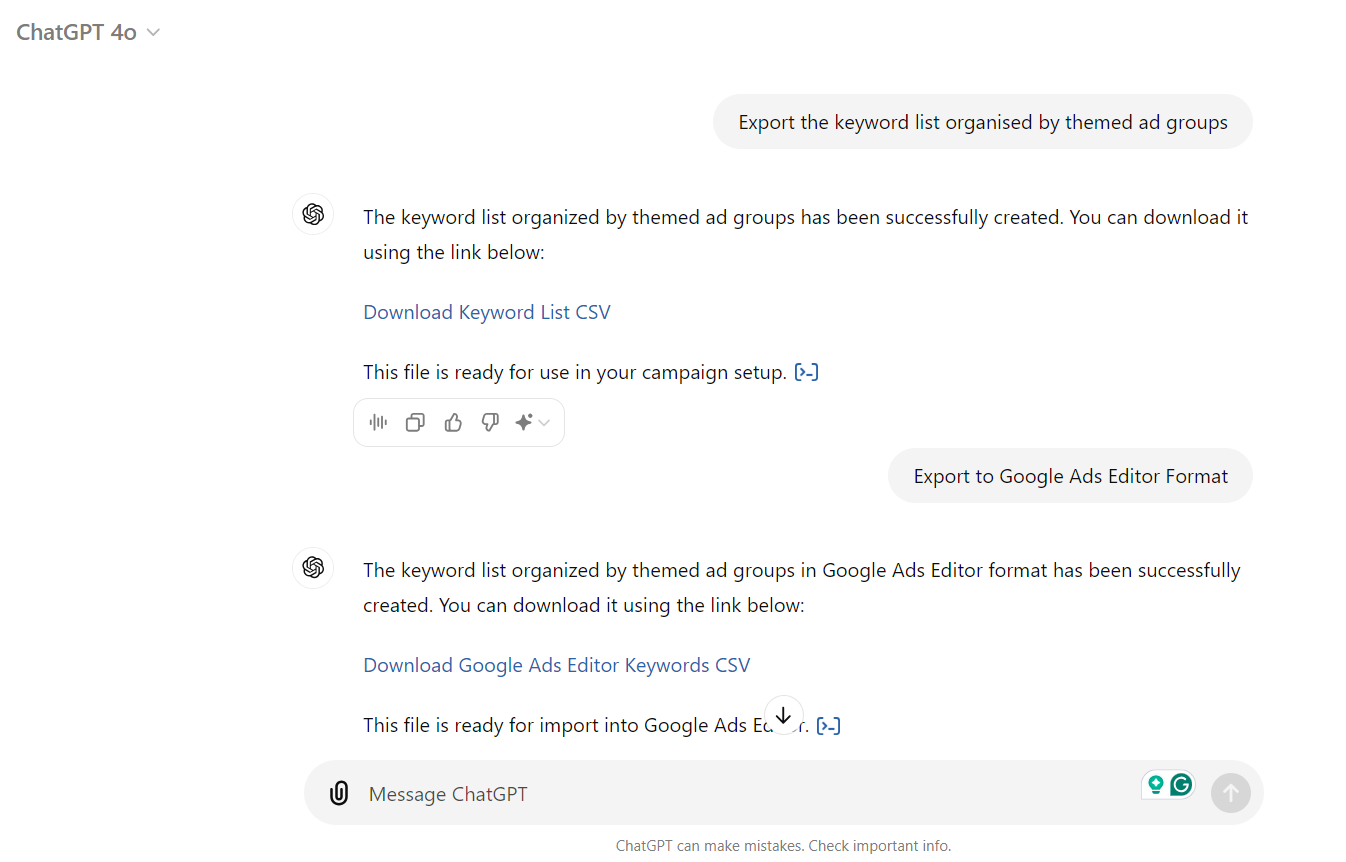
Create Adverts for LinkedIn and Facebook
In addition to Google Ads, ChatGPT can help you create effective adverts for other platforms like LinkedIn and Facebook. By tailoring the messaging and format to each platform’s audience and advertising best practices, ChatGPT ensures that your ads are both engaging and effective across multiple channels. This multi-platform approach maximises your reach and helps you connect with potential customers wherever they are.
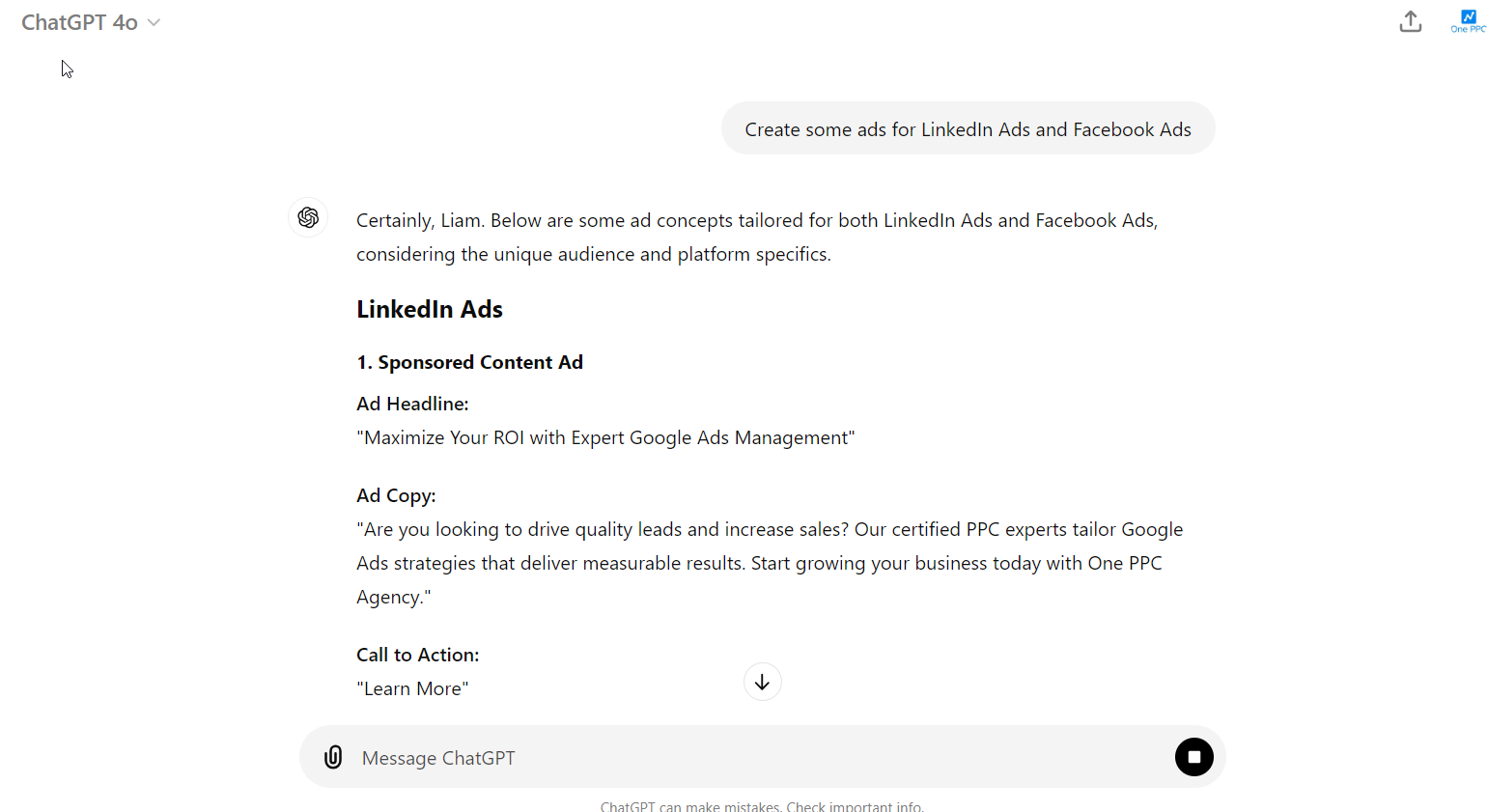
Using Chat GPT to Suggest Prompts
You give ChatGPT prompts for it to return answers. However, ChatGPT can also give you a list of prompts you can use with Chat GPT. So ChatGPT can train you how to use ChatGPT with Google Ads.
ChatGPT provides these Google Ads prompts that incorporate the use of AI technologies like ChatGPT to enhance various aspects of ad campaign management, including keyword research, audience segmentation, ad copy creation, and performance analysis:
Keyword Research
- “Utilise ChatGPT to generate a list of semantically related keywords based on core terms, aiming for a mix of high-volume and niche-specific opportunities.”
- “Employ AI to analyse search intent behind selected keywords and suggest adjustments to align with user expectations and behaviours.”
- “Instruct ChatGPT to conduct a competitor keyword analysis to identify gaps and opportunities in our current strategy.”
Audience Segmentation
- “Use AI to analyse behavioural data from our website and social media platforms to identify distinct audience segments that could be targeted with personalised ads.”
- “Deploy ChatGPT to synthesise customer feedback and reviews into actionable insights for audience targeting.”
- “Implement AI-driven models to predict customer lifetime value and segment audiences based on predicted profitability.”
Ad Copy Creation
- “Generate multiple ad copy variations using ChatGPT to test different emotional appeals and calls to action across various demographics.”
- “Utilise AI to adapt existing ad copy based on performance data, optimising for higher engagement and conversion rates.”
- “Instruct ChatGPT to create dynamic ad content that adjusts in real-time based on user interaction and feedback collected through ad performance metrics.”
Campaign Structure
- “Design a robust campaign architecture using AI to automatically allocate budgets based on performance data across different ad groups and campaigns.”
- “Set up AI-driven rules for bid adjustments, targeting real-time opportunities or scaling back on underperforming keywords automatically.”
- “Utilise ChatGPT to develop a predictive model for campaign performance based on historical data and market trends.”
Performance Analysis and Reporting
- “Deploy AI to perform deep analysis of ad performance data, identifying trends and anomalies that could impact campaign effectiveness.”
- “Use ChatGPT to generate comprehensive performance reports that not only present data but also provide insights and actionable recommendations.”
- “Instruct AI to continuously monitor ad performance and suggest real-time adjustments to optimise spend and ROI.”
Using Perplexity AI with Google Ads
Perplexity AI is a cutting-edge search engine that integrates generative AI to enhance its search capabilities, much like what ChatGPT offers. Essentially, everything we’ve discussed about using ChatGPT also be applied to Perplexity AI. You can use either platform individually or combine both to maximise your outcomes.
Perplexity AI’s key strength lies in its ability to not only retrieve search results but also generate in-depth, AI-powered responses that are highly contextual and tailored to your needs.
In addition to Perplexity AI, ChatGPT is soon releasing a search engine with similar functionalities. This new tool will allow users to combine the real-time search capabilities of a traditional search engine with the power of generative AI. Like Perplexity AI, ChatGPT’s search engine will offer the ability to generate detailed and actionable insights based on the user’s search queries. This opens up new opportunities to streamline research, improve ad targeting, and optimise marketing strategies using AI-generated data and recommendations.
https://www.perplexity.ai/search/using-AI-with-Google-Ads
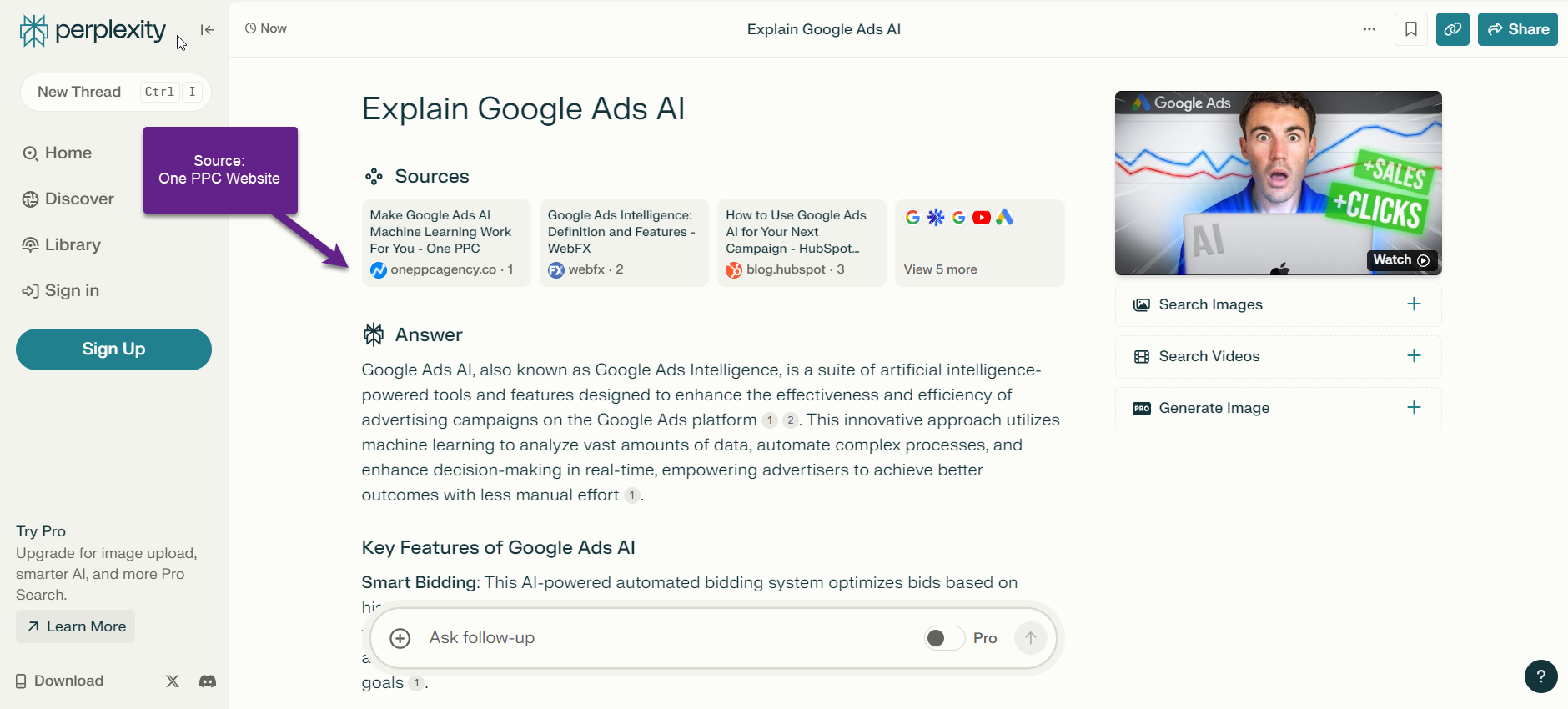
Google Ads AI
Google Ads has introduced a broader range of AI tools, including those that utilise generative AI similar to ChatGPT, as well as separate areas such as machine learning for bidding and optimisation.
These AI advancements enable advertisers to manage campaigns more efficiently by automating tasks that previously required manual effort. Machine learning optimises bidding strategies in real-time, ensuring that ads are delivered to the right audiences at the most cost-effective rates. Additionally, these tools analyse performance data to identify trends and insights, allowing advertisers to continually refine their campaigns for improved results
If you want to learn more, see our guide: How to Make Google Ads AI Work for You.
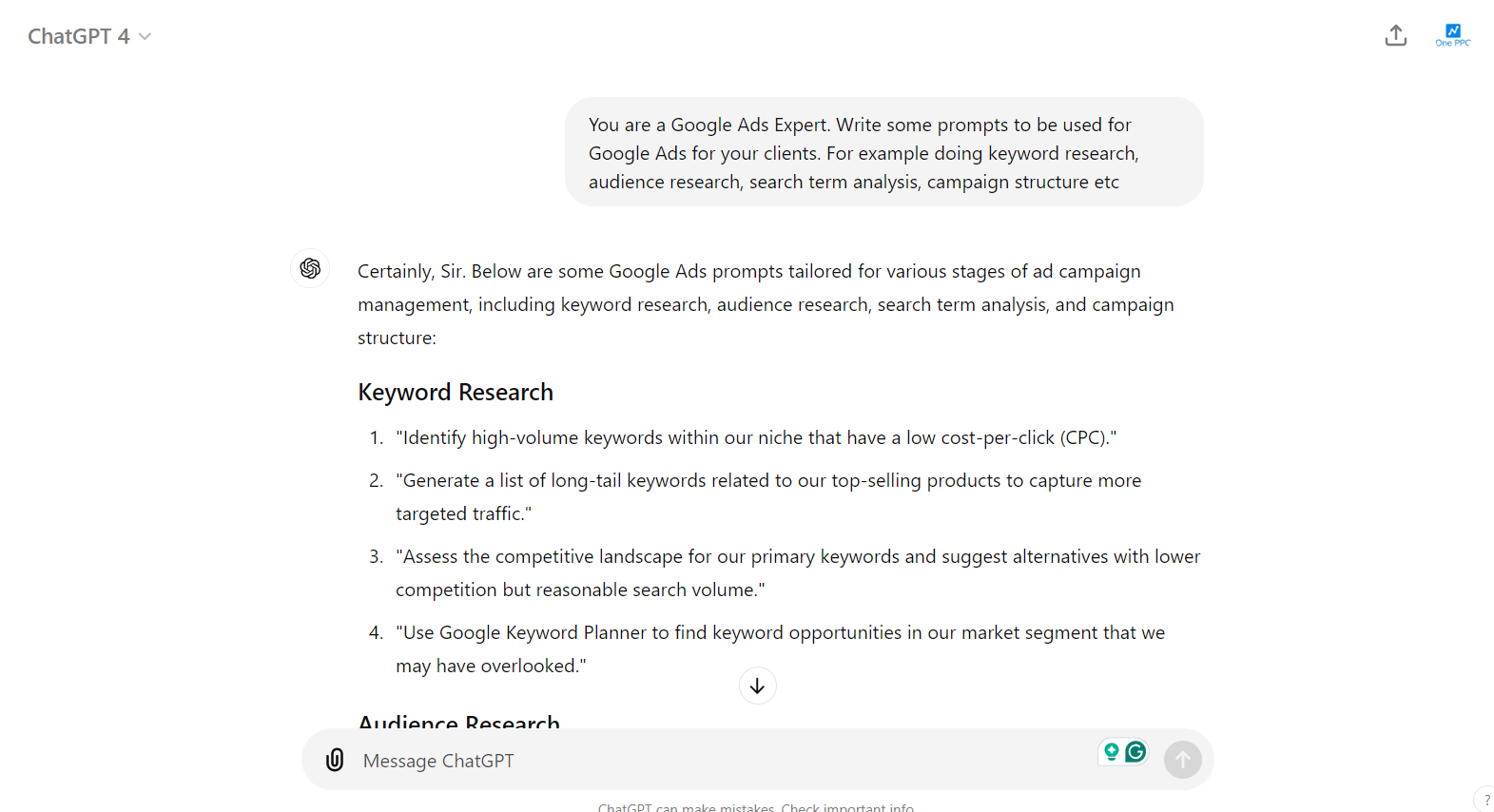
Conclusion
Utilising ChatGPT for Google Ads management transcends mere operational efficiency; it revolutionises how campaigns are strategised, executed, and optimised. This powerful AI tool offers a significant competitive advantage by automating key aspects of campaign management, from keyword research and ad copy creation to audience targeting and performance analysis.
The ability of ChatGPT to process vast amounts of data and provide precise, actionable insights allows marketers to make informed decisions that drive better outcomes. By embracing the capabilities of ChatGPT, businesses can enhance their creative processes, reduce wasted ad spend, and significantly improve the relevance and effectiveness of their advertisements.
In a digital advertising world where agility and accuracy are paramount, integrating AI tools like ChatGPT into your marketing strategy is not just an option—it’s a necessity for staying relevant and achieving sustained success. Let this guide serve as your roadmap to unlocking the full potential of your Google Ads campaigns, ensuring they are as dynamic and results-oriented as the rapidly evolving market they aim to conquer.